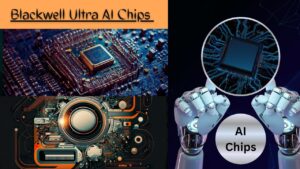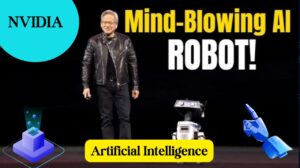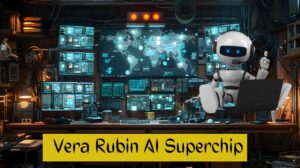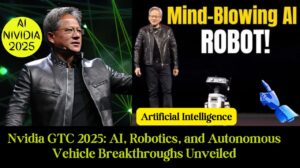1. Introduction
The rapid evolution of technology continues to reshape industries and societies globally. In 2025, the Nvidia GPU Technology Conference (NIVIDIA GTC) emerged as an event—jave, presenting innovative advances in artificial intelligence (AI), robotics, quantum computing, and autonomous vehicles. This report investigates the significant innovations presented in the GTC 2025, exploring its technical intricacies and possible impacts in various sectors.
2. NVIDIA GTC Conference 2025
Nvidia’s GTC 2025, normally nicknamed “AI Super Bowl,” served as a platform for the agency to expose its latest technological advances. Led by CEO Jensen Huang, the convention highlighted Nvidia’s transition from a chip manufacturer to AI infrastructure strength, emphasizing the important function of AI factories in revenue generation in various sectors.
3. Blackwell Ultra ai Chips
One of the cornerstone ads on NVIDIA GTC 2025 was the introduction of the Blackwell Ultra AI chips.

3.1 Architectural Innovations
Blackwell Ultra Chips represents a leap in chip architecture, designed to meet the growing demands of AI applications. These chips incorporate advanced parallel processing and enhanced energy efficiency features, establishing a new standard for AI hardware.
3.2 Performance improvements
Focusing on the acceleration of AI calculations, the Blackwell Ultra Chips offer unprecedented processing speeds. This performance impetus is critical for training AI models on a large scale and performing complex inference tasks, thus reducing time for business vision.
3.3 Sector Applications
The versatility of the Blackwell Ultra Chips extends through various sectors, including health industries, finance, and cars, allowing more sophisticated AI-oriented solutions and services.
4. Vera Rubin Ai Superchip Platform
Complementing the ad for Blackwell Ultra, Nvidia presented the Vera Rubin AI Superchip platform—NVIDIA GTC.

4.1 Design and resources
The Vera Rubin platform is designed to support expansive AI workloads, with integrated components that simplify data processing and model training.
4.2 Early impact on data centers
By integrating the Vera Rubin platform, data centers can achieve improved performance and efficiency, meeting the growing computational needs of modern AI applications.
4.3 Implementation Timeline
Nvidia plans to launch the Vera Rubin AI Superchip platform at the end of 2026, with an updated version, Rubin Ultra, expected in 2027.
5. Advances in Robotics
Nvidia’s commitment to advancing robotics has been evident in several important initiatives.
5.1 ISAAC GR00T N1: OPEN STRUCK HUMANOID
Isaac Gr00T N1 is an open-source model designed to facilitate the improvement of humanoid robots. This initiative is an ambition to democratize robotics research and boost innovation inside the subject.
5.2 Blue: collaborative improvement with Disney Research and Google DeepMind

In collaboration with Disney Research and Google DeepMind, Nvidia unveiled “Blue,” a robot powered by the Newton physics engine. This partnership exemplifies the convergence of amusement, IA, and robotics. 5.2 Blue: collaborative development with Disney Research and Google DeepMind.
5.3 Newton Physics Mechanism
Newton’s mechanism of physics improves robotic simulation resources, allowing a more realistic and efficient modeling of physical interactions.
6. Ai Factory OS: Nvidia Dynamo
To optimize AI inference computing, Nvidia introduced Dynamo, an AI factory operating system.
6.1 Increase the efficiency of AI inference computing
Dynamo simplifies the implementation and scale of AI models, improving efficiency and reducing operating costs for companies-GTC NVIDIA
6.2 Integration with existing systems
Designed for compatibility, Dynamo can be integrated into existing infrastructures, facilitating a perfect transition to more efficient AI operations.
7. Quantum Computing Initiatives
Recognizing the transforming potential of quantum computing, Nvidia embarked on significant initiatives in this domain.
7.1 OLELOT Chip: Reducing Quantum Computing Errors
In collaboration with AWS and Caltech, Nvidia GTC has contributed to the development of the Ocelot chip, which uses “cat qubits” to reduce quantum computing errors by up to 90%. This advance marks a crucial step towards scalable and reliable quantum computing.
7.2 Sector collaborations and future perspectives
Nvidia’s involvement in quantum computing highlights its commitment to pioneering technologies that promise to revolutionize industries through enhanced computational resources.
Read Nvidia’s official announcement
8. Autonomous Vehicles and AI Integration
Nvidia’s GTC 2025 Conference highlighted the employer’s key role in advancing self-sustaining car technology (AV) through strategic collaborations and revolutionary structures.
8.1 Partnership with General Motors-Nvidia GTC
Nvidia has announced a growth of its long-term partnership with General Motors (GM) to integrate synthetic intelligence into diverse aspects of GM operations. This collaboration is aimed at improving production procedures, robotics, and the improvement of next-technology automobiles. NVIDIA GTC will provide its AI infrastructure, which includes GPUs, to assist GM within the creation and training of AI models adapted for automobile packages. Jensen Huang, CEO of Nvidia, emphasized the means of this partnership, pointing out, “It’s time for self-reliant motors,” highlighting the vital function of good-sized education sets in this evolution.

8.2 NVIDIA HALOS: Safety and transparency in autonomous vehicles
In NVIDIA GTC 2025, Nvidia brought “NVIDIA Halos,” a comprehensive protection machine designed to enhance the improvement and implementation of independent cars. Halos is part of Nvidia’s hardware and software program answer set to make certain safety and transparency in self-reliant vehicles. This system targets to face vital challenges within the improvement of AV, presenting a robust shape for manufacturers to build safer self-sufficient cars.
By that initiative, NVIDIA GTC is strengthening its position within the leading edge of AI integration in the car enterprise, accelerating innovations that need transportation and mobility to work again.
9. Conclusion
NVIDIA’s GTC 2025 conference has made significant jumps, especially in AI, robotics, quantum computing, and autonomous vehicles in technological advances. The introduction of Blackwell Ultra AI chips and the Vera Rubin AI Superchip platform has established new benchmarks on AI processing resources, paving the way for more efficient and powerful AI applications. The development of humanoid robots, such as Isaac GR00T N1 and Blue, indicates a future in which AI-moved machines help in various sectors, including research, health, and manufacturing.
The launch of NIVIDIA GTC Dynamo as an AI factory operating system ensures that companies can maximize the efficiency of AI inference computing. Meanwhile, advances in quantum computing with the Ocelot chip indicate a promising future for error-free quantum operations. Nvidia’s collaborations in the autonomous vehicle sector, including the NVIDIA HOLOS initiative, highlight the company’s dedication to making autonomous technology safer and more transparent.
Overall, NIVIDIA GTC’s role as a leader in AI and computing innovation continues to grow, preparing the scenario for a future where AI-oriented systems transform industries around the world.
Stay ahead with live updates, keynotes, and expert insights, only on HamariiWeb!

